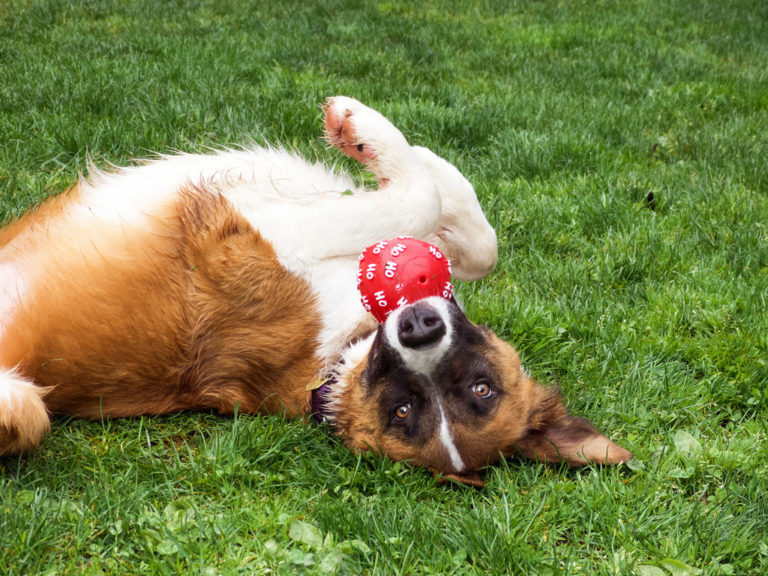“Safe” Toys
There are many factors that contribute to the safety or danger of a toy. Many of those factors, however, are completely dependent upon your dog’s size, activity level and play style. Although we cannot guarantee your dog’s enthusiasm or his safety with any specific toy, we can offer the following guidelines.
Safety First
The things that are usually the most attractive to dogs are often the very things that are the most dangerous. Dog- proof your home by checking for: string, ribbon, rubber bands, children’s toys, pantyhose and anything else that could be ingested. Toys should be appropriate for your dog’s current size. Balls and other toys that are too small can be easily swallowed or become lodged in your dog’s mouth or throat. Avoid or alter any toys that are not “dog-proof” by removing ribbons, strings, eyes or other parts that could be chewed off and ingested. Monitor your dog’s toys and discard any toy that starts to break into pieces or has pieces torn off. Ask your veterinarian about the safety of items like bones, hooves, pig’s ears and rawhides. Very hard rubber toys are safer and last longer. Take note of any toy that contains a “squeaker” buried in its center. Your dog may feel that he must find and destroy the squeak-source and could ingest it, in which case squeaking toys should be given only under supervision. Check labels for child safety. A stuffed toy that’s labeled as safe for children under three years old, and does not contain dangerous fillings is probably safe for pets too. Problem fillings include things like nutshells and polystyrene beads; however, even a “safe” stuffing is not truly digestible. Remember that soft toys are not indestructible, but some are sturdier than others. Soft toys should be machine washable.
Toys We Recommend
Active Toys:
- Very hard rubber toys, like Kong products. These are available in a variety of shapes and sizes and are fun for chewing, fetching and for carrying around.
- “Rope” toys that are usually available in a “bone” shape with knotted ends.
- Tennis balls make good fetch toys, but some dogs may chew off and ingest pieces.
Distraction Toys:
- Kong-type toys, especially when filled with broken-up treats or, even better, a mixture of broken-up treats and a small amount of peanut butter. The right size Kong can keep a puppy or dog busy for hours. By chewing diligently your dog can access the treats in small bits – very rewarding! Double-check with your veterinarian about giving peanut butter to your dog.
- “Busy-box” toys are large, hard plastic cubes or balls with hiding places for treats. The dog has to move the toy around with his nose, mouth and paws to access the goodies inside. These toys should be large enough that your dog cannot get his mouth around it.
Comfort Toys:
- Soft stuffed toys are good for several purposes, but are not appropriate for all dogs. For some dogs, the stuffed toy should be small enough to carry around. For dogs that want to shake or “kill” the toy, it should be the size that “prey” would be for that size dog (mouse-size, rabbit-size or duck-size).
- Dirty laundry, like an old t-shirt, pillow case, towel or blanket, can be very comforting to a dog, especially if it smells like you! Be forewarned that the item could be destroyed by industrious fluffing, carrying and nosing.
Get The Most Out Of Toys!
- Rotate your dog’s toys weekly by making only four or five toys available at a time. Keep a variety of types easily accessible. If your dog has a huge favorite, like a soft “baby,” you should probably leave it out all the time.
- Provide toys that offer a variety of uses – at least one toy to carry, one to “kill,” one to roll and one to “baby.”
- “Hide and Seek” is a fun game for dogs to play. “Found” toys are often much more attractive. Making an interactive game out of finding toys or treats is a good “rainy-day” activity for your dog, using up energy without the need for a lot of space.
- Many of your dog’s toys should be interactive. Interactive play is very important for your dog because he needs active “people time.” By focusing on a specific task, like repeatedly returning a ball, Kong or Frisbee, or playing “hide-and-seek” with treats or toys, your dog can expel pent-up mental and physical energy in a limited amount of time and space. This greatly reduces stress due to confinement, isolation and/or boredom. For young, high-energy and untrained dogs, interactive play also offers an opportunity for socialization and helps them learn about appropriate and inappropriate behavior with people and with other animals, like jumping up or being mouthy. Soft stuffed toys are good for several purposes, but are not appropriate for all dogs. For some dogs, the stuffed toy should be small enough to carry around. For dogs that want to shake or “kill” the toy, it should be the size that “prey” would be for that size dog (mouse-size, rabbit-size or duck-size).
- Dirty laundry, like an old t-shirt, pillow case, towel or blanket, can be very comforting to a dog, especially if it smells like you! Be forewarned that the item could be destroyed by industrious fluffing, carrying and nosing.
Tug of War
- Tug of war has long been thought to be an absolute “don’t” in many dog-owning households. However, by taking a few precautions and setting some basic rules it can be a fun game for you and your dog.
- Choose a toy that will be reserved exclusively for this particular activity. This will help prevent your dog from grabbing and tugging anything you have in your hand.
- “Let’s tug” begins the game. Never allow the dog to initiate tug on his own and always use your starting phrase when you begin the game.
- “Give” or “Out” ends the game. Teach your dog to release the toy by offering a treat or better toy in exchange.
- Do not start playing tug with your dog until he is consistently releasing the toy on command. If your dog does not give up the toy on command, stop the game immediately. Wait until he gets interested in something else and then put away the toy for use at another time. You may also take obedience breaks during the tug game. Each time the dog puts down the toy, ask for a few simple commands and then continue the game. Anyone in the family who cannot follow the rules of the game should not play tug with the dog. If your dog has shown signs of aggression towards you, tug of war is not a game we recommend.

